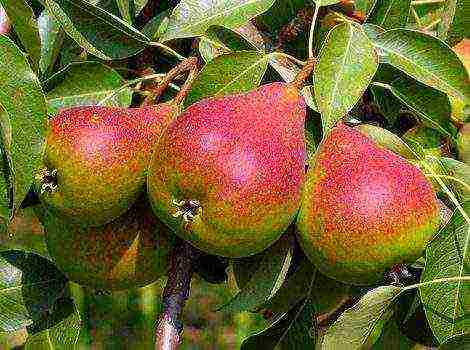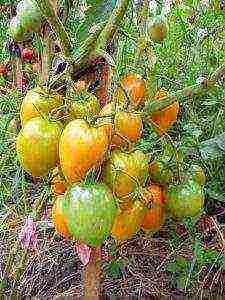Content
- 1 Early varieties of apples
- 2 Types of late apple trees
- 3 Summer varieties
- 4 Autumn varieties of apples
- 5 Winter
- 6 The sweetest and tastiest fruits and their names
- 7 Best green
- 8 Best reds
- 9 The best apple varieties for the Moscow region and the middle zone
- 10 What apple trees and where to grow
- 11 In Belarus
- 12 In Ukraine
- 13 Triploid apple trees
- 14 Good and winter-hardy varieties of apples: names and descriptions
- 15 Undersized apple trees
- 16 Popular varieties
- 17 Gardeners reviews
- 18 Classification of varieties
- 19 List of the most popular apple trees
- 20 White filling: description
- 21 Moscow pear
- 22 Melba
- 23 Antonovka
- 24 The most delicious autumn varieties of apples: Zhigulevskoe
- 25 Apple trees Simirenko
- 26 The most delicious winter varieties of apples: Golden Delicious
- 27 Instead of a conclusion

Those varieties of apple trees that were popular with our grandparents are gradually becoming a thing of the past. Nowadays you rarely see in the gardens Grushovka Moskovskaya, Korobovka, Aport, Borovinka, Kitaika Zolotaya early, and even Antonovka is gradually losing ground. Despite the pleasant taste and other advantages, these varieties are in many ways inferior to those that have been bred over the past few years.
Varieties with which it's time to say goodbye
New varieties of apple trees with improved characteristics of yield, winter hardiness and resistance to the most common diseases appear in the State Register every year. Some of the currently popular varieties of apple trees are distinguished by absolute immunity to scab, others are valued for their excellent keeping quality and shelf life, while others attract with their beautiful appearance and wonderful dessert taste.
It is not at all necessary to plant in your garden exclusively seedlings of those varieties that have proven themselves well twenty or thirty years ago. Try to replace them with new varieties that domestic gardeners have already fallen in love with. It is unlikely that this choice will disappoint you!
Video about apple varieties
How to deal with various diseases of apple trees from year to year, worry about how the trees will survive the winter, and unsuccessfully try to increase the yield, isn't it better to get rid of old varieties? Let's figure out which apple trees you can refuse without regret.
For example, in an old variety Cinnamon striped the apples, although tasty, are not very attractive in appearance, and the yields are not high enough. And apple varieties Autumn striped grow too large, start bearing fruit late and are weakly drought-resistant.Instead of these varieties, it is better to plant the Orlovskoe striped variety with mouth-watering tasty apples and good yield, or Cinnamon new - a variety that begins bearing fruit early, productive and is immune to scab.
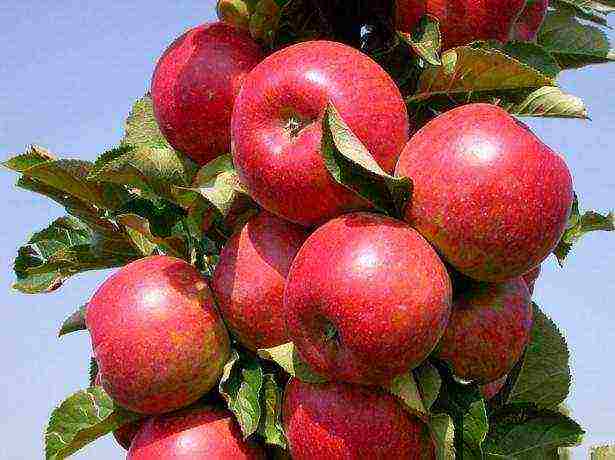
Canadian Quinti is not winter-hardy and scab resistant
Quinty and Folding - summer varieties of apple trees, which are also not very suitable for cultivation. Canadian Quinti is not winter-hardy and scab resistant, Papirovka does not bear fruit every year, besides, apples are very sour, becoming tasteless when overripe, and do not tolerate transportation well. Gardeners preferred Canadian Melba with delicious fruits to these varieties. And the new varieties Early Aloe and Orlinka are not only high-yielding and fast-growing, but in addition surpass Melba in winter hardiness.
From winter-hardy varieties, you can say goodbye to North synap, giving not particularly tasty fruits, with Pepin with saffron, prone to frequent scab damage, as well as with a variety Memory of Michurin, from which it is difficult to wait for a good harvest. Antonovka ordinary with all its positive qualities, it disappoints gardeners with irregular fruiting, short shelf life of apples and the manifestation of "sunburn" on the fruits during storage. Antonovka has no analogues in terms of fruit taste, but its yield and ripening times can be replaced by such varieties as Legenda, Cinnamon new, Brusnichnoe, Marat Busurin.
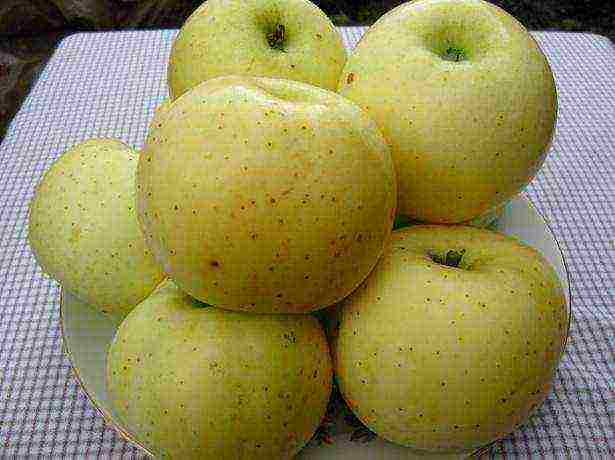
Apple variety "Antonovka ordinary"
The best apple varieties bred in recent years
Through the efforts of breeders, genes for apple tree resistance to the most dangerous diseases and genes for dwarfism were identified - something that was missing in the old varieties of apple trees. So, now in the world there are more than 150 varieties that are immune to scab, which means that they do not require treatment with fungicides.
Among the new varieties of apple trees, the following are distinguished by the best characteristics: Liberty, Golden Resistant, Baritone, Enterprise, Ligol, Krasa Sverdlovsk, Lovely Red, Green Blues, Askolda, Williams Pride, Champion, Capital Red, Radogost, Bullfinch. Most of the listed varieties have already become widespread abroad, but in our country they are only gaining popularity.
Video about early summer varieties of apple trees
We present to your attention a brief description of apple varieties that have already earned the love of Russian gardeners:
- The apple variety Medunitsa has become a real find for those who like sweet apples with a honey flavor. Their taste is most pronounced immediately after removal from the branch; fruits can be stored in the refrigerator until January. Fruiting of apple trees begins already in the fourth year, the yields are plentiful, regular, but with age they become periodic. The Medunitsa variety is immune to rot and scab.
- The Legend apple variety has a sweet, candy taste. Quite large conical fruits of dark red color have an attractive presentation and the same size. With proper care, the productivity of apple trees is very high, fruiting is annual. Winter hardiness and disease resistance are about the same as that of the best traditional varieties.
- Summer variety Mantet is valued for its early maturity, winter hardiness and good (albeit periodic) yield. Apples begin to ripen from the end of July, they are recommended to be consumed within a month. The pulp of the fruit is very juicy, aromatic, tender, sweetish with sourness. The Mantet variety is unstable to powdery mildew, but it is resistant to scab.
- Until March, the fruits of the Orlik variety, a winter variety of apple trees that ripen by mid-September, can be stored (you can see the photo in the tab to the article). The yellow fruits, covered with a solid red blush, have a harmonious sweet-sour dessert taste and a bright aroma. The winter hardiness of apple trees is sufficient, the resistance to scab is average.

Apple variety "Orlik"
- The late winter apple variety Bogatyr is famous for its high yields.Its large fruits with a pink blush are very aromatic and tasty - their sweetness is successfully complemented by a slight sourness. Fruiting begins in the fifth year after planting.
Particularly noteworthy are the varieties of apple trees included in the State Register that are absolutely resistant to scab: Solnyshko, Imrus, Bolotovskoe, Jubilee of Moscow, Orlovskoe Polesye, Freshness, Kandil Orlovsky, Start, Zdorov'e, Rozhdestvenskoe.
From the south to the north of our country, the apple tree is a favorite fruit crop. People have been cultivating it for a long time, and therefore there are more than 10,000 varieties of apples, old, known for a long time, new or recently brought to us! They differ in size, shape, taste of fruits: from bitter, unleavened, sour to very sweet, so everyone can choose what he likes.
Apples are: summer, that is, early, usually in July, they ripen, they do not lie well, the shelf life is about three weeks, in which they need to be eaten or processed.
Apples autumn categories begin to collect in September, they can be stored until mid-winter. Harvest late, or winter, finally ripens at the end of autumn. Apples in this category are distinguished by good keeping quality and winter hardiness.
It is curious that both autumn and winter varieties of apples can ripen during storage. We will consider the best and most popular in each of the categories in the form of a list with illustrations, so that it is possible to determine and recognize the name of the fetus from the photograph.
Early varieties of apples
Apple trees in this category begin to bear fruit already in the first 3 years after planting, and sometimes even earlier.
North synap
 North synap
North synap
North Sinap came from Crimea, although it now grows in the northeastern regions of Russia. Comes from the Kandil-Chinese variety.
Is different good winter hardiness and keeping quality, the fruits can be stored until May-June, which makes it very popular. Fast-growing, gives a stable, bountiful harvest of delicious apples.
For good fruit ripening, it requires a lot of summer heat, therefore, in regions with a short and rather cold summer, apples simply will not ripen. Harvesting is worth it finally ripe, since unripe fruits will not have characteristic taste, and during storage they can wither, but not ripen. But ripe fruits will have the best taste after two to three months of lying.
Medium resistance to fungal diseases and drought. Suitable for fresh consumption, processing into juice, compote and jam, as well as for making dried fruits.
Melba
 Melba
Melba
The famous early-growing variety Melba, which came from Canada. Melba bears fruit literally for 3 years. This apple tree is grown almost everywhere in Russia, with the exception of the Far East, the Urals and northeastern Siberia.
Is different high yield... The flesh of the melba is snowy, the skin is smooth. The fruits are not small, sweet and sour, with a pleasant candy aroma. Melba apples are well transported and, with proper storage, lie until November, unripe - until January, without losing their attractiveness and taste, which favorably distinguishes the variety from other summer ones.
The harvest is harvested late summer and early autumn... Melba does not withstand frosts well, becomes infected with scab, mature trees do not bear fruit regularly. But the dry hot summer is not scary for her.
More than 20 new species were bred on the basis of the Melba apple tree.
Student
 Student
Student
Late winter, Student harvest falls on September and first half of October... Differs in a particularly early fruiting period: apples appear in the second year. The variety is popular in central Russia.
The fruits are not too large, but they have an attractive appearance, they have a pleasant, sweet and sour taste. The apple tree tolerates frost quite well, it is resistant to scab. The fruits have good keeping quality, easy to save until May. Ripen for a long time, the harvest is removed in October.
Types of late apple trees
Idared
 Idared
Idared
Apple-tree varieties Idared - tall wood. Begins to bear fruit 5-6 years after planting. The apples are rather large, green in color with a yellow or red blush, pleasant taste, the flesh is firm and juicy.
The harvest is harvested at the end of September, and apples lie before the beginning of spring. The variety is resistant to brown spot, however, it is affected by powdery mildew and scab. Used fresh, making juice and compotes, as well as dried fruits.
Bogatyr
 Bogatyr
Bogatyr
A variety that begins to bear fruit 5 years after planting. The advantage of the Bogatyr is the ability to grow him in almost any climatic zone.
The fruits have a pleasant sweet and sour taste, firm and strong, juicy. Until the harvest, apples remain light green; during storage, they turn yellow, and a blush may appear. Resistant to scab, frost-hardy, well transported and consistently bears fruit. Harvesting takes place in September, with proper storage, apples lie until the end of spring.
Mac
 Mac
Mac
A unique variety of Macintosh originally from Canada. Fruits are whitish yellow or green with purple or beard stripes.
Begins to bear fruit 6-7 years after planting. The harvest is harvested late September - early October, after which it lies for 2-3 weeks and only after that it is considered ripe.
Apples are moderately sweet, rich in taste. Possesses medium keeping quality, the fruits are stored until early spring and when fully ripe, the pulp becomes slightly transparent. Winter hardiness and scab resistance are average.
Summer varieties
In most regions of Russia, summer is not long, and therefore summer apples are sometimes not a frequent treat. Apple trees in this category ripen early and begin to bear fruit.
To date, breeders have bred many varieties of apple trees that can be grown in regions previously considered unsuitable for their growth.
Summer apples are usually juicy, sweet and delicious... Their biggest drawback is poor keeping quality... They are eaten fresh, juices are made and canned. Let's take a look at the best ones.
White filling
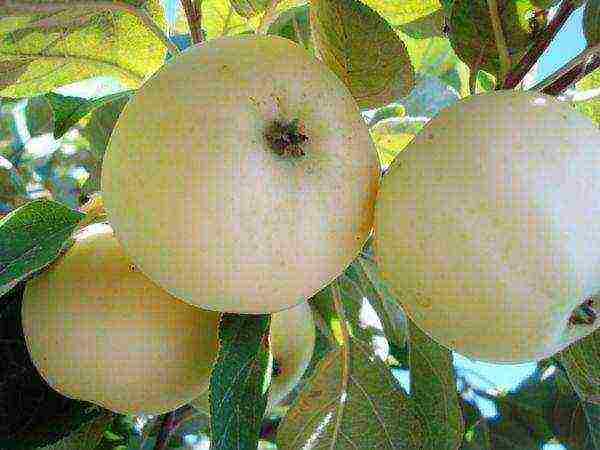 White filling
White filling
Popular, widespread, ancient variety. Fruits of White filling of noble ivory color, from where the name comes from. The apple tree has a white filling of medium height, an adult tree grows up to 5 meters in height, the crown is pyramidal.
White filling is winter hardy, but it is highly vulnerable to wood pests, therefore it requires regular treatments. They have a sweet and sour taste. The harvest is harvested in August.
Apples deteriorate quickly, especially when hit or dropped, because stored for a very short time... Therefore, it is most correct to immediately eat or process them. Do not allow overripening of the fruit, since in this case the taste deteriorates markedly, the pulp becomes mealy and almost tasteless.
The fruits of the white filling deteriorate not only when dropped, but even when you press firmly on them with your finger, dark spots appear, the pulp looses, becoming dry and mealy. Therefore, apples must be removed very carefully.
.
Folding
 Folding
Folding
Another well-known variety that is often confused with white filling. But this is not entirely correct. As relatives, they still have differences. The birthplace of the Papirovka apple tree is the Baltic States. Begins to bear fruit early, already 5 years after planting.
It tolerates frost well, but not resistant to scab, traces of which can be seen both on the foliage and on the apples themselves. The harvest ripens a week earlier than the white filling. The flesh of the papier is white, coarse-grained, contains an increased level of ascorbic acid, therefore the taste of apples is refreshingly sour. It resists the influence of pests and diseases quite well, but suffers from drought and frost.
Papier fruits poorly transported and lie, stored for about three weeks, quickly rot if damaged. If you want to keep them for some time, you need to harvest unripe.Also well suited for processing and preservation.
Candy
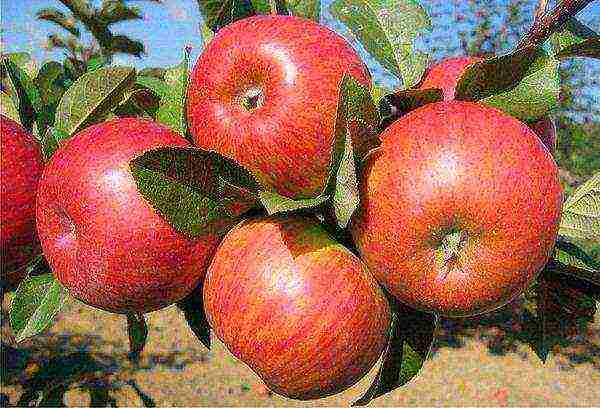 Candy
Candy
A variety of apples obtained by the Michurin method from white filling and boxing. Apple trees Candy are distinguished by their rapid development and growth, at the age of 5 they begin to bear fruit, have a powerful spreading crown.
They are unpretentious, winter-hardy, which is an undoubted advantage for many Russian regions. Pruning trees helps to increase the yield, as well as the ability to form a bush from the tree. Due to frost resistance, cultivation is possible even in Siberia.
The fruits ripen in mid-August, from one tree you can harvest up to 50 kg. The fruits are smooth, with a sweet taste and excellent presentation. Apples are quite good keeping quality; they can be stored for up to two months.
The main difference between winter apples and summer apples is that winter apples should be eaten after they have lay for at least a month.
Grushovka Moscow
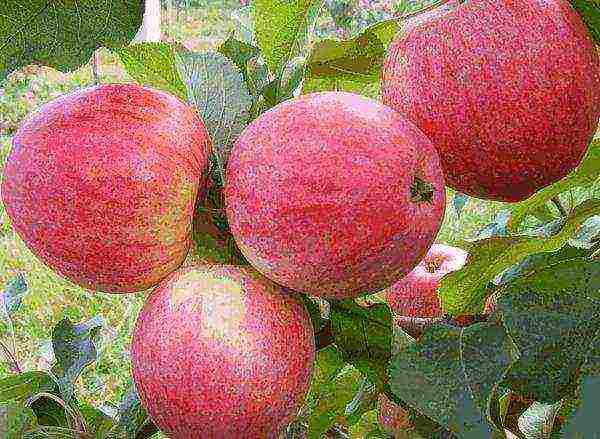 Grushovka Moscow
Grushovka Moscow
Apple tree withstands frosts down to -50, therefore it can be grown in many Russian regions, even in the Urals and Siberia. It is one of the most frost-resistant. They begin to bear fruit as early as 5 years after planting, the harvest ripens in July-August, but do not bear fruit en masse. Apples inside the crown and at the top ripen at different times, which significantly complicates the harvest.
The pulp of apples is juicy, but after picking it quickly becomes mealy. Fruit do not tolerate transportation and practically are not stored. In rainy weather, they are prone to scab infestation, and in drought conditions, the tree may even shed its fruits.
Moscow pear is not very suitable for preservation, because apples have a sour taste, which will require a lot of sugar. But at the same time, they contain a lot of vitamins B and C, therefore it is better to use them fresh.
Mantet
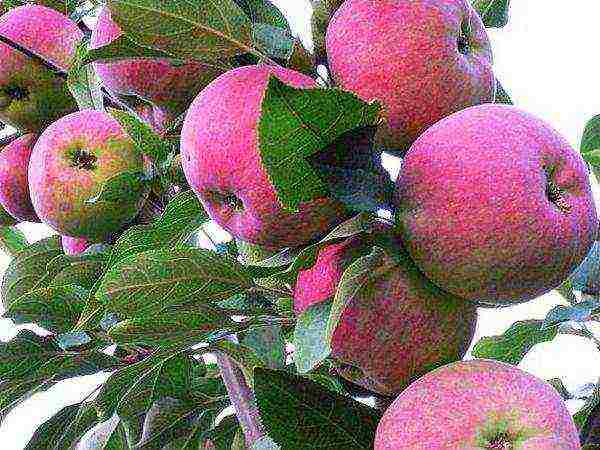 Mantet
Mantet
Has Canadian roots, bred by natural pollination of the Moscow pear tree. The apples are round-oblong, slightly ribbed at the top, bright. The taste of Mantet is very sweet, practically without the presence of sourness, the flesh is white and aromatic.
Ripen from the end of July to the end of August... Fruiting early, but the fruits are stored for no more than two weeks. Trees are prone to scab do not tolerate frost.
Summer striped
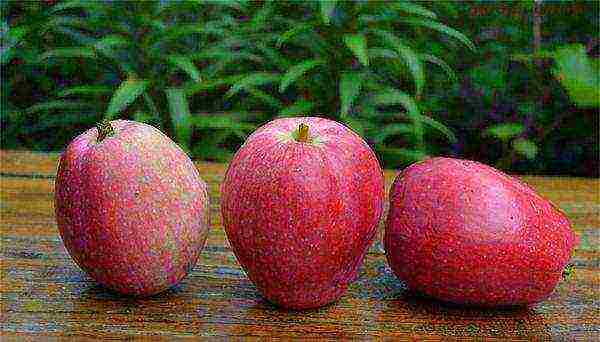 Summer striped
Summer striped
As the name implies, the color of the fruit is striped, which is its distinguishing feature from other varieties. The apple tree is quite unpretentious to care for, it is immune to scab, frost-resistant... When grown in almost any conditions, you can get a high yield of tasty, juicy, fragrant apples with delicate pulp.
Fruits are stored poorly, overripe and not harvested in time, the crop will simply crumble from the tree. Suitable for fresh consumption, jam and compotes.
Quinty
 Quinty
Quinty
Quinti was bred about 30 years ago in Canada, from where he came to us. Created specifically for regions with relatively low average annual temperatures. Fruit ripening occurs early, the harvest is already harvested from mid-July.
The fruits of the apple tree are small, with a persistent, bright aroma and sweet-sour taste. Despite the early ripening of the crop, resistance to powdery mildew, drought and heat, which are the undoubted advantages of the variety, the fruits are stored for a very short time, only about two weeks. Apple tree quinti not hardy and affected by scab.
Autumn varieties of apples
Autumn apples are most suitable for all types of preservation... Consider the best and most popular ones.
Autumn striped
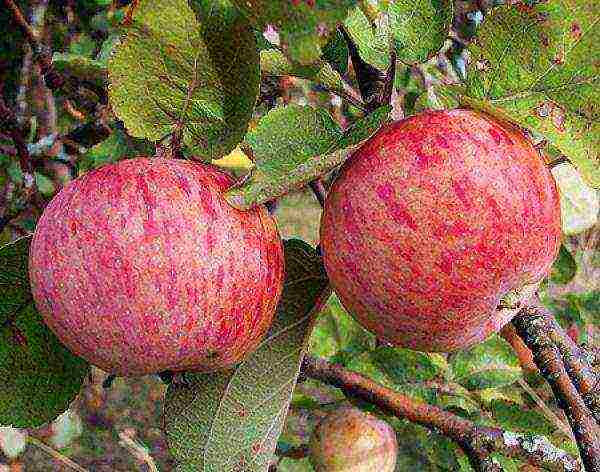 Autumn striped
Autumn striped
The variety is considered one of the best in its category. High-yielding, different average winter hardiness, the planted tree begins to bear fruit at the age of 7-8. Ripening in the second half of September, the fruits remain on the tree for a long time without dropping. Stored until mid-December.
Fruits are medium in size, with a blurred blush, with a creamy flesh of a pleasant taste.
Despite the high quality of the apples, the variety is not drought tolerant.
Cinnamon striped
A popular and well-known apple variety.It differs in that bountiful harvests begin to give rather late, after 14-15 years. Highly resistant long-lived variety, tolerates long-term severe frosts.
Fruits with cream-colored pulp, high taste and cinnamon aroma, which is why they gave this name. Harvesting takes place in September, laying time - up to two months. Apples are good for soaking and jam. In rainy weather, the variety is susceptible to scab disease.
Consumer maturity, that is, the time when autumn apples can be eaten, comes after 2-3 weeks of maturation.
Borovinka
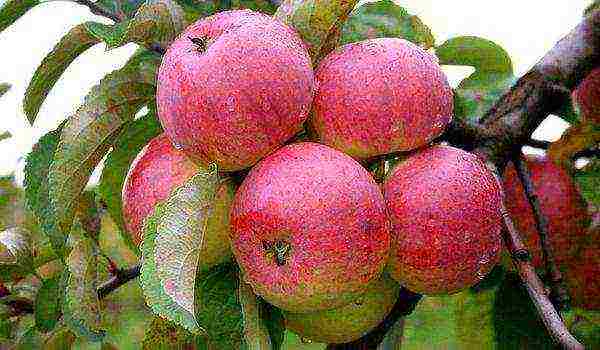 Borovinka
Borovinka
Winter hardy unpretentious Borovinka variety with regular fruiting.
The fruits ripen in the beginning of September, and can lie until November. The apple tree begins to bear fruit already from 4 years after planting, the fruits are juicy, yellowish, of average taste. Despite the high tolerance to low temperatures, the tree has fragile wood, the nondescript taste of the apples themselves. Fruits and leaves are prone to scab.
Isaev's memory
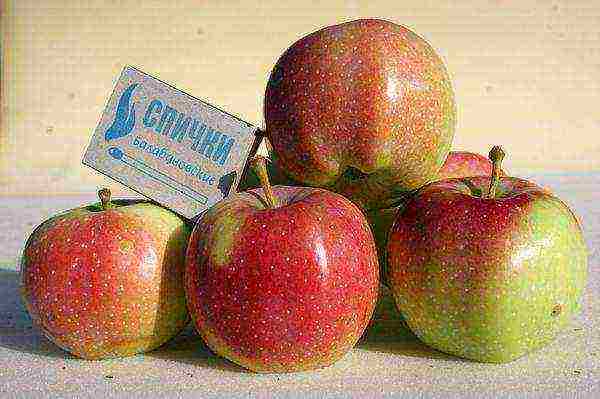 Isaev's memory
Isaev's memory
Variety Pamyat Isaeva, possessing extremely high winter hardiness, high yield. Harvesting takes place late autumn, and the harvested fruits are stored until January.
Apples are distinguished by a sweet and sour taste, they do not have a pronounced aroma, with a dense, juicy and delicate pulp. Scab resistant.
Glory to the winners
 Glory to the winners
Glory to the winners
Matures in September-October, the harvested harvest of rather large fruits is stored for up to three months.
Apples Glory to the winners of sweet and sour taste, juicy and very tender. Begins to bear fruit early, already at 4 years old, good disease resistance and winter hardiness.
Bolotovskoe
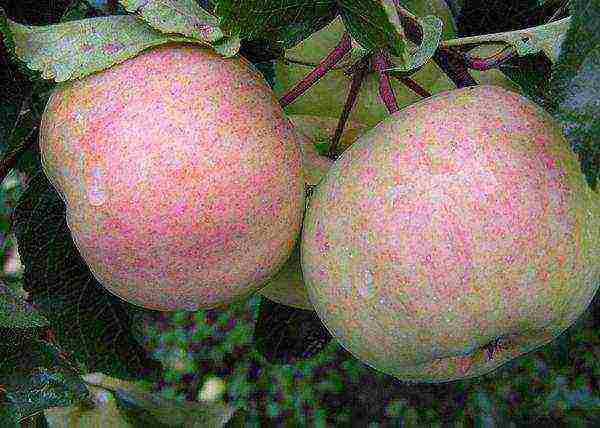 Bolotovskoe
Bolotovskoe
Giving high yields, well tolerant of frost grade. Large fruits with a pleasant sweet and sour taste ripen in the beginning of September.
Winter
Apple varieties with a late ripening period are called winter apples. Winter apples are valuable because you can eat them for a whole year... The best varieties of this category have such good keeping quality.
Winter apples are difficult to eat right after harvest, as they usually ripen during storage. The crop is harvested from mid-autumn, and the fruits lie until May-June.
Knight
The fruits ripen in the first half of Octoberare stored until April-May. The trees are large in size, the harvest is abundant, up to 240 kg. The tree is powerful, scab and resists frost moderately... Therefore, it requires special attention in winter, and also requires regular spraying.
The fruits are quite large, with excellent taste. Stored until May, suitable both for raw consumption and for all processing methods.
Growing winter varieties of apples is more difficult due to the small amount of heat, in contrast to summer and autumn ones. For this reason, they need more careful care and regular feeding.
Antonovka
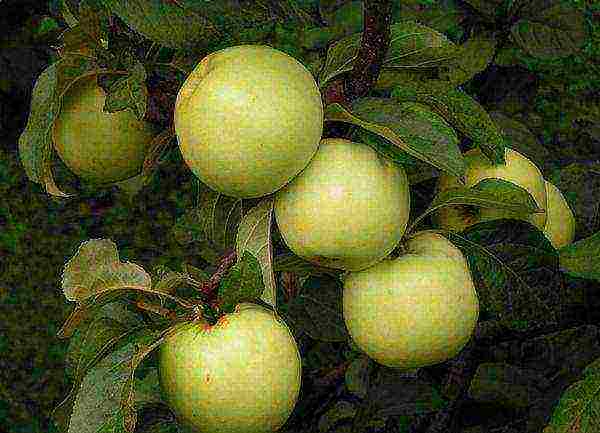 Antonovka
Antonovka
A well-known and popular variety. It has quite a few types: white, ribbed, gray, striped, and so on. All of them are distinguished by high, but not regular yields. Frost resistant and tolerates other climatic troubles well.
Antonovka fruits have a characteristic aroma of high intensity, sweet with sour taste, juicy and crunchy pulp.
The harvest is removed in the first decade of October... Depending on the storage method, apples of this variety lie: in the refrigerator - until December, in the basement - until December. They are eaten fresh, and also processed into jam, marmalade and marshmallow, compotes and juices are made.
Renet Simirenko
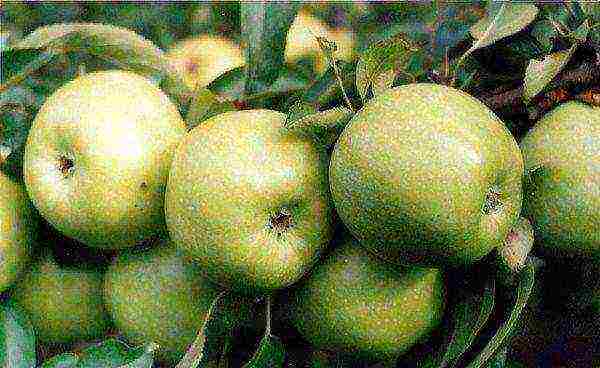 Renet Simirenko
Renet Simirenko
Apple trees of the Renet Simirenko variety are distinguished by their resistance to drought and strong winds. The trees grow very tall with medium to large green fruits in various shades. A distinctive sign is the formation of a brown tint on the fruit.
Possess very high keeping quality, stored until summer. The harvest of juicy fruits with a spicy, slightly salty wine, sweet taste is removed in September-October.Mainly suitable for fresh consumption.
Antaeus
 Antaeus
Antaeus
A variety that can withstand the coldest winters. Highly frost resistant.
Ripening, the fruits turn red, have a pleasant tangible aroma, juicy and sweet. It is not uncommon for apples to have a waxy coating, which helps to increase the keeping quality of the fruit.
Harvesting falls on late September-early OctoberI, but apples can be stored almost until the end of spring. You can eat them after 2 months of laying, when they are fully ripe.
Sinap (Kandil) Orlovsky
 Sinap Orlovsky
Sinap Orlovsky
The trees are quite large in size, with large fruits almost equal in size. The apples are green with a blush, sweet with a slight sourness. The harvest is harvested at the end of September, apples lie until spring.
Scarlet anise
 Scarlet anise
Scarlet anise
Brought to the Volga region, therefore tolerates both severe frosts and drought... Scarlet Anise begins to bear fruit rather late, 6-7 years after planting, bringing abundant harvests.
Harvesting takes place In November, keeping quality is limited to two months. An unpretentious apple tree, but if the weather is too humid, the fruits and leaves are infected with scab.
Ripe fruits are almost completely covered with a scarlet blush, small in size, and have a good taste.
The sweetest and tastiest fruits and their names
Adults and especially children love to enjoy a delicious, sweet apple. The best known in this category are the white and candy fillings we talked about earlier. In addition to them, there are also popular varieties of this category.
Belarusian sweet
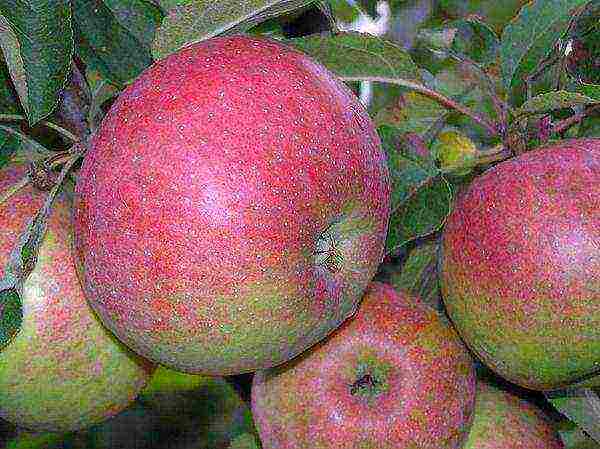 Belarusian sweet
Belarusian sweet
Winter hardy early type. Due to its large size, the tree is able to withstand quite large fruits. The apples are sweet, with a very aromatic but not too dense pulp.
The harvest is removed at the beginning of October, and the fruits lie until the end of February. Possessing excellent taste and presentation, besides, it is resistant to scab.
Sweet bliss
A medium-sized tree with sour-sweet fruits of a round shape and small size. Light apples with a blush are characterized by an excellent aroma, sweet dessert taste without the presence of sourness.
Arkad yellow
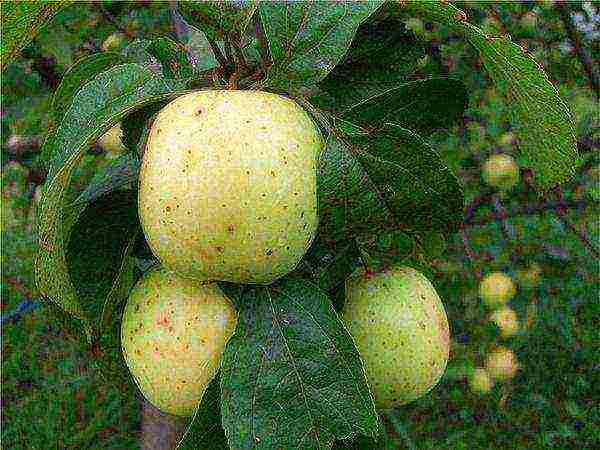 Arkad yellow
Arkad yellow
Resists adverse environmental factors well. Is different high frost resistance.
The fruits are small, cylinder-like, yellow in color, with a very sweet taste and pleasant aroma. The yield is average.
Nectar
Summer hardy grade. Fruits are medium to large in size, sweet, with a slight sourness and honey flavor. Maturation occurs in late August and lasts for a month.
Winter hardiness is very high, withstands frosts down to -40. Good disease immunity and pest resistance.
Korobovka
 Korobovka
Korobovka
Grown in central Russia, Belarus and the Baltics. Summer ripening perfectly tolerates frost.
The yield is average, and the tree begins to bear fruit rather late. The fruit is small in size, very aromatic, with a honey-sweet taste. The foliage and the apples themselves are scab resistant. Ripen late July-early August... However, keeping quality is low, stored for a month.
Lungwort
A variety with uneven ripening, the crop is harvested in the second half of August... The taste of apples improves after a short maturation, becoming even sweeter honey. Taste qualities remain unchanged for a long time.
Best green
Green, with a sour taste, green apples are considered most beneficial to health and with diets. Among them are the most popular Renet variety Simirenko, as well as papirovka, Antonovka and White filling, described above, and others.
Granny Smith
 Granny Smith
Granny Smith
Probably the most popular winter green apple variety right now, it is difficult to confuse with others due to its bright, shiny green color and tough skin. Bred in Australia. The fruit taste is very juicy with a pleasant sourness, it is considered dietary due to its low sugar content.
Late ripening, ripens by the end of autumn. The fruits are large and have no aroma, which is their feature. They tolerate transportation well and can be stored for a long time. Frost resistant, with regular abundant fruiting. However, with a lack of heat and light, the fruits become smaller and turn yellow.
Granny Smith is the most popular apple for weight loss diets.
Pepin saffron
Pepin saffron variety does not have good frost resistance and in severe cold freezes, although after good it is restored. For regular fruiting, it requires regular pruning, the first harvests it brings 5-7 years after planting.
The apples are sweet, with an interesting grape and spicy aftertaste, with a bright aroma. Possess good keeping quality from the moment of collection in October perfectly stored until March, retaining their taste.
Golden Delicious
 Golden Delicious
Golden Delicious
Despite the yellowish color, the variety still belongs to this category. Apple tree tolerates frost well, but drought resistance is low.
Dense, very juicy fruits with a sweet taste are harvested From september, and stored until March. Lying down has a positive effect on the taste, making it even more delicate.
Best reds
Beautiful, bright apples will decorate any table and seem especially tasty. The best varieties in the category are the following.
Florina
French variety, scab resistant. Large, slightly flattened apples ripen in October... Begins to bear fruit at the age of 6, but good harvests are harvested only at 8-10.
The quality of the fruits is very high: sweet, juicy, with signs of sourness, when lying down they become even sweeter. Well transported and stored until March. Frost and drought resistance average.
Gloucester York
 Gloucester York
Gloucester York
A variety with large, bright red fruits of a beautiful shape. Excellent taste, appearance, but medium scab resistance. The tree begins to bear fruit 5 years after planting, but it gives significant yields only by 10 years.
Red Delicious
A fast-growing variety, the first harvests can be removed in 3-4 years. You need to do this at the end of September, and the fruits lie until the end of winter, with proper storage until April.
The apples are rich, bright red, with a dense skin, sweet, with a slight iron aftertaste, juicy and crunchy. They are well transported, resistant to mechanical damage, but during storage they are affected by bitter spotting. It has no resistance to scab, but frost resistance average.
Jonathan
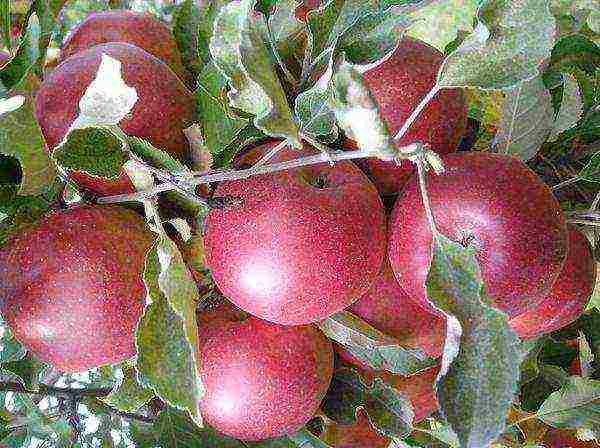 Jonathan
Jonathan
Late winter variety originally from America. It is also known to gardeners under other names: winter good, winter red, Oslamovsky. You need to grow on wet soils, only under this condition you can get good yields. The tree is resistant to both scab and powdery mildew.
Fruits with a pleasant, sour taste with sweetness and a bright aroma remove in mid-September... It tolerates transportation and storage well, lies until mid-spring.
Jonathan fruit is most commonly mentioned in recipes and used in baked goods.
Lobo
The variety originated from Macintosh, and therefore has its properties: deep red color, wonderful taste. The variety is distinguished by annual fruiting with a noticeable increase in yield, the first can be removed after 3-4 years.
Tolerates frost well and is resistant to drought, but is moderately resistant to disease.
The best apple varieties for the Moscow region and the middle zone
The Moscow region is characterized by an unstable climate, short summers and a lack of light. Therefore, the varieties that are best suited for growing should be hardy, unpretentious and frost-resistant.
Among the summer varieties are suitable: Moscow pear, lungwort, candy, cinnamon striped, which were mentioned above. As well as autumn varieties of apples.
Autumn
Zhigulevskoe
The first fruits of Zhigulevsky are removed 5-6 years after planting, the yield is abundant, but decreases over the years.
A characteristic feature of the variety is very large fruits... But it is better to plant in the southern regions, since the variety does not tolerate frost and weakly resists scab. Matures in September, and the harvested apples lie up to two months.
Cinnamon new
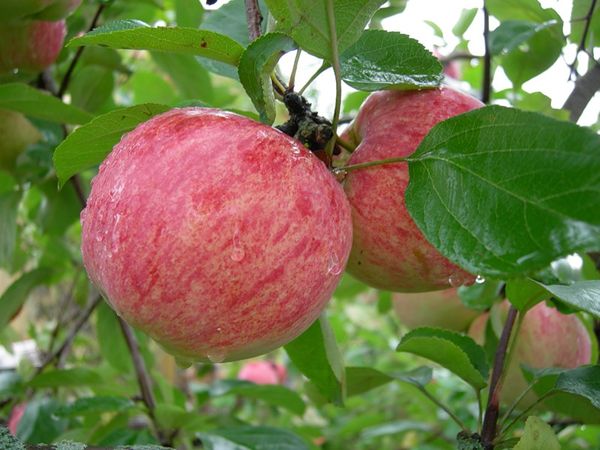 Brown new
Brown new
Another autumn apple variety suitable for growing in the Moscow region. The first crop is harvested quite late after planting, closer to 6-7 years. At first, the trees bear fruit regularly, over the years the yield increases, but becomes irregular.
Fruits are small, juicy, fragrant, with bright spots. in mid-September, they are stored for about three months. Winter hardy, pest resistant cultivar.
Among the winter varieties suitable for cultivation in this region, it is worth noting the already described antonovka, saffron pepin, borovinka, long, Kandil Orlovsky and some others.
Star
Variety with average winter hardiness, but good resistance to scab and various pests. Begins to bear fruit at the earliest - after 5 years of cultivation, the harvest from light striped fruits is harvested in the fall and stored for about six months.
Moscow winter
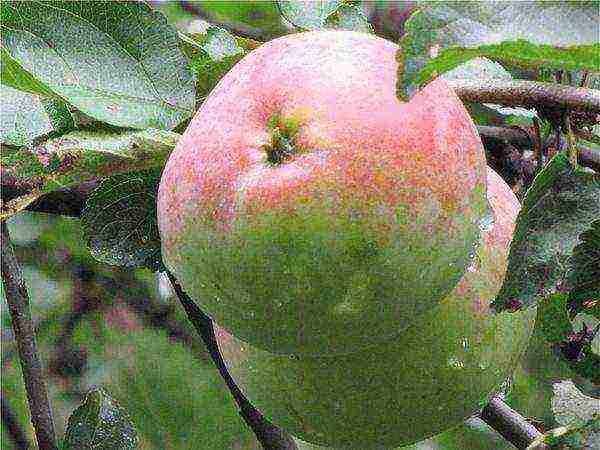 Moscow winter
Moscow winter
Good, frost-resistant Uslada variety with excellent resistance to pests and various diseases.
After 5-7 years, you can harvest a good harvest, the apples are large, sweet and sour, green in color with a bright blush. Ripen in September-October, with proper storage, lie until April.
Early
Delight
Semi-dwarf autumn variety, bears fruit well from 3 years of growth. A fast-growing, high-yielding apple tree with medium-sized red fruits. Due to the thickened crown, the size of apples is different, their taste is sweet and sour. Especially valuable for scab immunity and good resistance to frost.
Wonderful
By the third year of cultivation, good harvests of sweet and sour apples can be harvested. Frost resistant and scab, loves feeding, but it is necessary to fight aphids.
Dwarf tree, yellow fruits in the second half of August, are stored for a month.
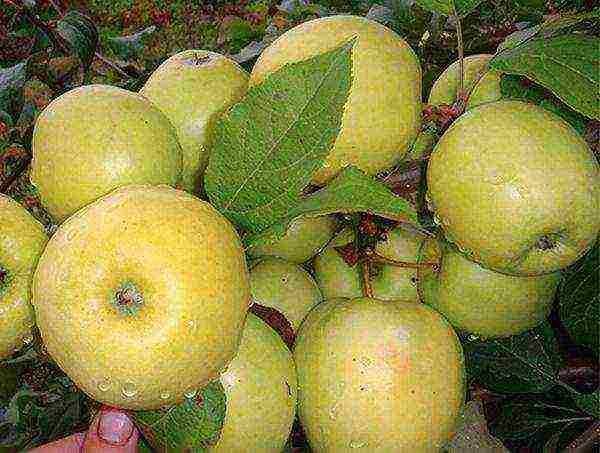 Wonderful
Wonderful
The described varieties of apples are considered the best, because they are very popular and popular with many gardeners. By planting summer, autumn and winter varieties together, you can enjoy delicious fruits all year round.
The apple tree is one of the favorite fruit trees of Russian gardeners. It must be grown on the site, if only the space permits. Since the selection is constantly developing, the cultivation of new varieties is now possible not only in areas with the most suitable climate for gardening, but also in the Urals, Siberia, and the Far East. Accordingly, the apple tree must be chosen based on the characteristics of the climate and the possible vagaries of the weather in a certain area.
What apple trees and where to grow
The climate of Russia is very diverse. These are both warm southern regions, which are almost ideal for gardening, and areas to which the definition of "risky farming zone" is quite suitable. In no case should you forget about this when choosing an apple tree for your personal plot, otherwise the money and time for caring for it will be wasted.
In outskirts of Moscow
The climate in the Moscow region is rather unstable; winters can be both quite warm and very cold. Therefore, it is better to choose varieties of apple trees that are resistant to such temperature fluctuations, and in order to be on the safe side, it is imperative to build a shelter or otherwise protect them from quite possible frosts. At the same time, statistics show that winters in the Moscow region are gradually becoming warmer, and most of the precipitation occurs in summer. For gardening, this climate is quite favorable.
Zhigulevskoe
The achievement of Soviet breeders is Zhigulevskoe, a variety of late apples that ripen during September. The specific period is influenced by the weather in summer. The fruits will have to be picked 3-4 times, they ripen in "waves". It is popular due to its high yield (provided that there are pollinating varieties) and presentability of fruits weighing 180–250 g. Smooth glossy shiny burgundy skin.The pulp does not differ in juiciness. Taste qualities are rated by professionals at 3.8 points out of five. Fresh apples have a shelf life of 6–8 weeks.
The tree reaches a height of 5.5–6 m. The crown is wide, slightly thickened. It practically forms itself; from the gardener, only sanitary and growth-inhibiting pruning is required.
Zhigulevskoe has average winter hardiness. If the temperature in winter drops below -30 ° C, old shoots may freeze. Young shoots are less sensitive to frost. The rootstock of cold-resistant varieties - Brusnichnoe, Anis can solve this problem. A significant drawback is the lack of immunity to scab.
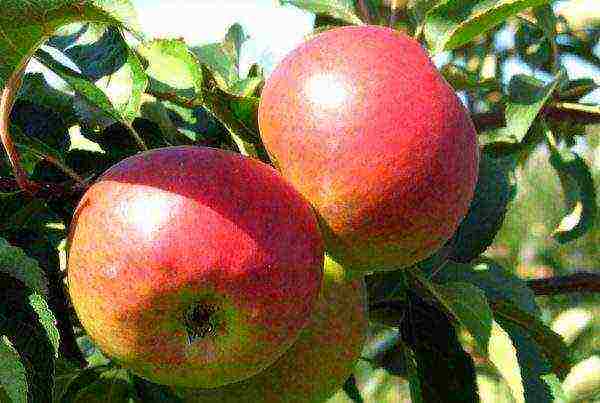
Apple tree Zhigulevskoe is a vigorous tree that needs annual pruning
Grushovka Moscow
Popular summer variety. The first apples ripen somewhere in the middle of August, fruiting lasts 2-3 weeks. The taste of apples is sweet and sour, refreshing, the pulp has an amazing aroma. But this only applies to fresh apples. They will lie for a maximum of a month, then they will almost lose their taste, the pulp will become "cottony". The peel of apples is yellowish, with a pinkish "blush". Each fruit weighs approximately 80 g.
The height of an adult apple tree is more than 6 m, the crown is very thickened. In young trees, it resembles a pyramid, over time it becomes more spreading, gradually turning into an almost regular ball.

The Moscow pear tree needs a lot of space in the garden
Delight
A variety of apples, the ripening of which stretches from mid-summer to the end of September. The first fruits are removed while still green, then the skin acquires a rich dark red hue. The aroma of freshly picked apples is reminiscent of raspberries. The variety is self-infertile, pollinators are President, Orlik, Bogatyr.
The tree grows up to 3–3.5 m. The spherical crown stretches as it matures, gradually turning into an oval one. The first harvest can be counted on 4–5 years after planting; an adult apple tree consistently bears 85–100 kg of fruits.
Delight almost never gets sick with scab, even if the summer is very rainy, it tolerates frost well. The apple tree needs to be cut off regularly, otherwise the fruit shrinks.
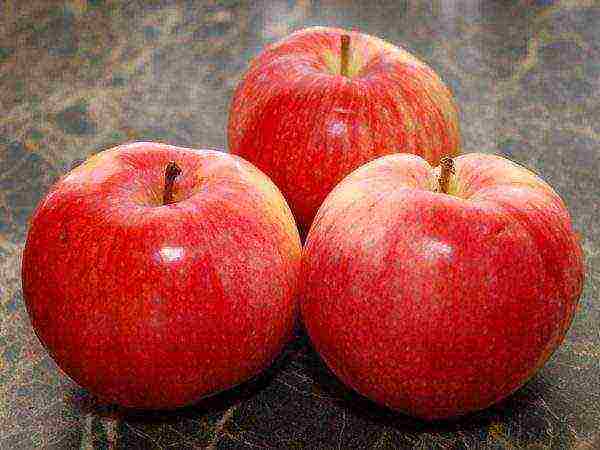
If you do not take care of the Delight apple tree, the fruits quickly become smaller
Lead or Streyfling
Also, this Baltic variety is known as Autumn striped. Strifel differs from the rest of the apple trees in size - up to 8 m in height with a crown diameter of 7–10 m. It does not differ in early maturity - the first harvest is removed 7–8 years after planting the seedling. The variety is self-infertile, as pollinators are suitable for Welsey, Papirovka, Antonovka.
The tree is sensitive to drought and requires regular watering. Winter hardiness - within -25 ° C. At lower temperatures, the tips of young branches may freeze. The yield is simply amazing - 320–350 kg per apple tree. But she alternates such successful seasons with lean ones. About once every 4–5 years, you don't have to wait for apples.
An apple weighs 100 g or a little more. They are round in shape, the ribs are easily felt. They are very juicy. The skin is yellowish-green, with stripes gradually changing from pinkish to crimson. The taste is harmonious, sweet and sour; notes of clove are often caught in the aroma. The fruits do not differ in keeping quality, the maximum shelf life is a month.
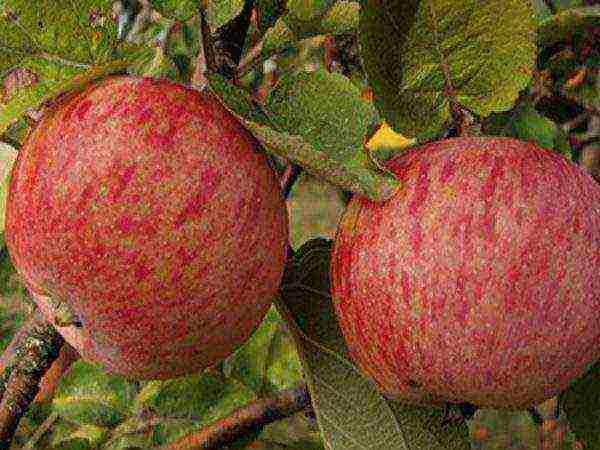
Strifel is one of the most popular Baltic varieties
Lungwort
An "old well-deserved" variety of apples ripening at the very end of summer. Inherited from parents excellent cold resistance and almost absolute immunity to scab. Begins to bear fruit in 4–5 years after planting the seedling. Until about the 15th year of the tree's life, harvests are annual and abundant, then successful seasons in this regard alternate with unsuccessful ones.
The apple in the form of a flattened ball weighs 120–150 g, the flesh is sweet. The skin is yellowish-cream, with a purple spot that occupies almost half of its surface. The shelf life is 20-30 days.
The lungwort is resistant to scab and all types of rot. It can be grown even where underground waters come very close to the surface, which is, in principle, not typical for apple trees.

The lungwort, unlike other apple trees and fruit trees in general, can grow and bear fruit where groundwater comes very close to the surface.
Orlinka
Summer apples, valued for their excellent taste, as well as their immunity to scab and cold resistance down to -30 ° C. Professionals give taste a score of 4.3-4.5 points out of five. Presentability is also all right - apples of medium size (150-200 g), uniform. They seem to be slightly flattened, the ribs are almost not felt. The skin is glossy, yellowish cream, with bright crimson blush spots. Under it there are many large dots of salad color. The pulp is crispy and firm.
Fruits ripen en masse in mid-August, do not differ in keeping quality (shelf life - only 15–20 days). You can count on about 200 kg per apple tree. Some specimens can hang on it until the end of September, but this is not good for the taste, the flesh becomes almost transparent, watery.
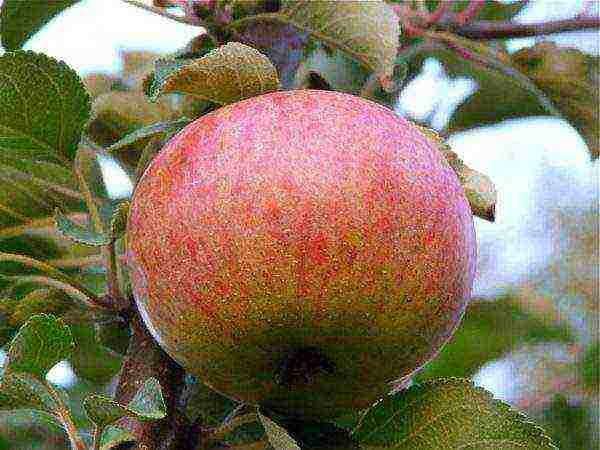
You should not hesitate in picking Orlink's apples, the quality of the fruits is sharply deteriorating
Candy
Early ripening variety of apples (3-4th year after planting). The abundance of fruiting cannot boast (50–90 kg), but the taste of apples is beyond praise. It will be possible to save them for 3-4 weeks, no more.
They ripen at the junction of July and August. The apple weighs 120–150 g. The pulp is sweet, the taste has a slight hint of honey. The skin is golden, with a peach blush.
The tree is of medium height - about 4.5 m. The crown is spherical, not spreading, densely leafy, requires regular pruning. Trees are often sick with scab. As we age, productive seasons alternate with periods of “rest”.

The taste of Candy apples fully justifies the name
Melba
A well-known Canadian apple variety, grown not only at home for over a century. Apple trees grow up to 4–5 m, the initially elongated crown then gradually changes its shape to a wide one. Fruits ripen closer to the 20th of August.
Apples weighing 160-200 g, slightly flattened. The green skin gradually changes its tone to yellowish and becomes covered with burgundy stripes of blush. Ripe apples can be distinguished by their whitish coating. Characterized by multiple subcutaneous dots of a pale salad color. The pulp is snow-white, melting in the mouth. The smell is honey-candy, the taste is sweet, with almost indistinguishable sourness. Ripe (not overripe) fruits will last until the end of autumn, harvested slightly unripe - until the New Year.
Apples tolerate transportation well. Melba often suffers from scab, as it ages, fruiting cycles are noted. It is a favorite material for breeders' experiments.
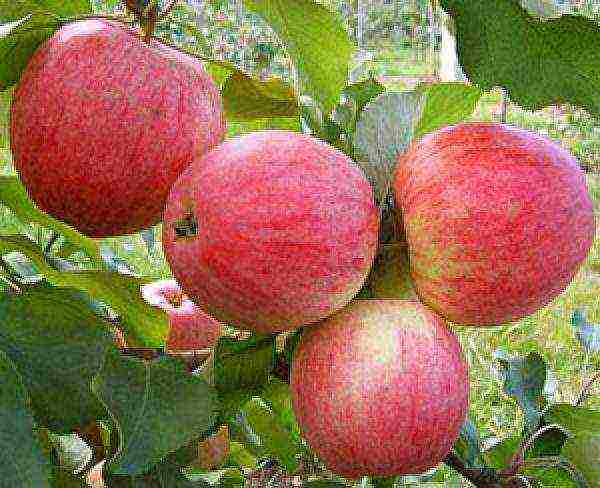
With Melba's participation, breeders have created more than 20 new varieties, including the first scab-resistant Prima
Pepin saffron
Winter apple variety by the famous IV Michurin, one of his best achievements. Partially self-fertile, but planting near Welsey, Antonovka, Slavyanka has a positive effect on yield. Fruiting every year, you can count on 250-280 kg of apples.
Then the fruit ripens for about 6-8 weeks and can be stored until March-April. Taste and presentability are not affected in any way. The apples are rather small, weighing 90–130 g. The skin is thick, greenish-yellow. The blush is bright, crimson. Multiple small specks are visible under the skin. The taste is harmonious, with subtle sourness. The stalk is very strong, ripe apples do not crumble even with sharp gusts of wind.
The apple tree needs to be pruned annually, otherwise the fruits become very shallow, and when individual shoots freeze, it quickly recovers. The variety is often infected with scab and various types of rot, for some reason the moth is especially fond of it.
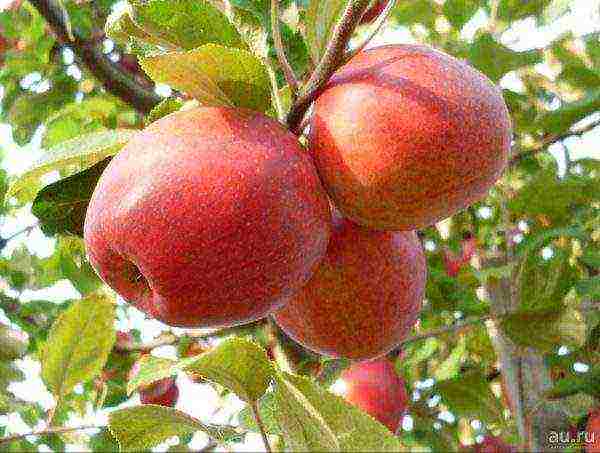
Pepin saffron is deservedly considered one of the best achievements of I. V. Michurin
White filling
An early variety that every gardener has heard of. It is often confused with Papirovka. The apple tree grows up to 4.5–5 m, the crown is wide.At first it resembles a pyramid, then more like a ball. Productivity - up to 180 kg from an adult tree, then decreases to 80-100 kg. Winter hardiness is very high.
Even mature apples have a very pale skin, almost indistinguishable yellowish-green hue, hence the name. In the sun, they appear translucent. Under it, brighter salad dots are clearly visible. As the tree ages, the apples gradually shrink from the initial 120–140 g to 60–75 g. The fruits resemble a rounded cone with an obligatory "seam" on the side.
The pulp is tender, rather loose. If you do not remove the fruit in time, it turns into a cotton candy, the characteristic sweet and sour taste changes to a mealy. The first wave of apples ripens at the 10th of August, the next one - in about 3 weeks. They are stored for a maximum of 10-12 days.
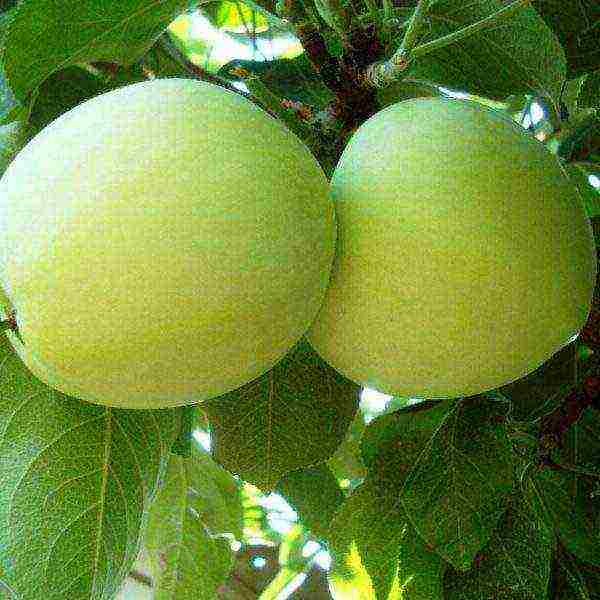
Now apples White filling is grown more for nostalgic reasons, in order to feel the same "taste of childhood", the variety is not devoid of significant drawbacks
In the Urals
In the Urals, even apple trees specially bred for this region often do not survive. They are also almost regularly exposed to recurrent spring frosts, which occur during the flowering period. It is best to purchase those varieties that are bred in the Urals.
Bugler
Very common in the region. The height of the apple tree is 4.5–6 m, it is quite powerful, with a pyramidal crown. The variety is self-fertile, as any other apple tree with the same flowering time will do as a pollinator. The bugler is not afraid of colds down to -50 ° C, it is very rarely infected with scab.
The apples are medium-sized, weighing about 100 g. But fruiting is annual and abundant (about 200 kg). The fruit is uniform, a bit like eggs. The ribs are hardly palpable. The skin is light yellow, the blush is indistinct crimson strokes. The taste is wonderful - 4.4-4.5 points out of five. Fruits ripen towards the end of August, they are not stored for a long time (maximum 15–20 days).
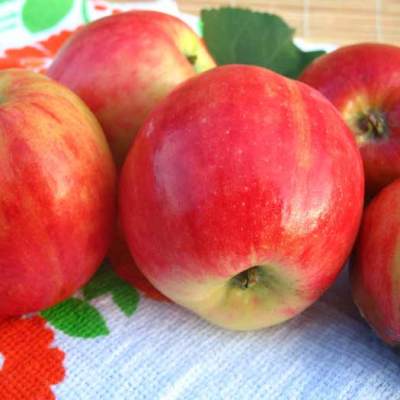
Hornist is one of the most common apple varieties in the Urals.
Ural bulk
Late ripening apples. The culture is very undemanding to the quality of the soil. The leaves on this tree bloom before anyone else. It is not too high (up to 4 m), but with a very dense crown. Branches slightly sag with age. The first time a tree bears fruit is 2 years after planting. About 250 kg of fruit are removed from an adult apple tree.
And so small (55–75 g) fruits on old trees become smaller up to 35–40 g. The skin of ripe fruits is sunny yellow, with indistinct spots of pinkish blush. The pulp is yellowish cream. Light sourness is practically not felt.
If you plan to prepare compotes and juices, fruits are harvested in the first decade of September. Apples for eating - in 15 days. The October ones are great for any preparations. Fresh will lie for 8-10 weeks.
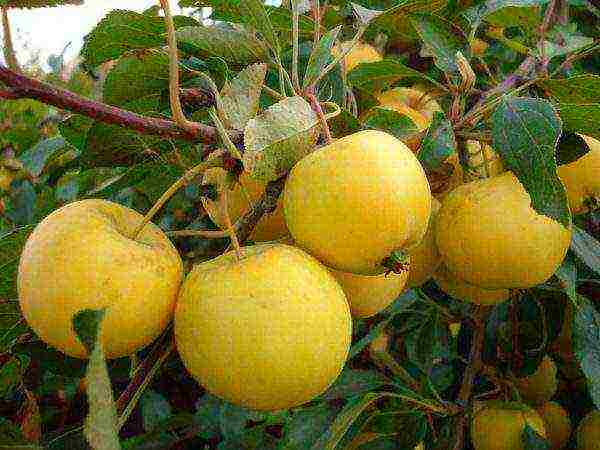
Ural liquor - medium-sized, but very sweet apples
Silver Hoof
A popular summer variety of apples. Of all the Urals, it was he who received the greatest distribution in Russia. The tree is 3-4 m high, the crown is spherical, rather dense, but very compact. The variety is self-fertile, the best pollinator option is Anis Sverdlovsky. The apple tree is prone to scab and rot infestation, especially if the summer is rainy.
The weight of apples is determined by the quality of the substrate, varying from 75–80 g to 110–125 g. Fruits are round, the skin is yellowish-cream. Ripe apples are covered with a whitish coating. Blush is blurry, reddish. The pulp is firm.
Fruits ripen in the second half of August. Even perfectly ripe apples do not fall from the trees. After 10-15 days, they become similar to the White filling, acquiring a similar translucency. The shelf life of ripe apples is 4–6 weeks. The fruits tolerate transportation well.

Silverhoof apples become very shallow when grown in infertile soil
Beauty of Sverdlovsk
One of the most promising Ural varieties, which is of interest all over the world.Significant disadvantages are self-infertility and cold hardiness not always sufficient for the Urals within -30 ° C. The apple tree is medium-sized, up to 4 m. A characteristic feature is burgundy buds. The variety cannot boast of early maturity (6–7 years), but then the yield is excellent - 220–250 kg per tree.
Fruits weighing 170–250 g, slightly tapering towards the bottom. The pulp is fine-grained, crispy.
Fruits ripen in September. If long-term storage is planned, they are removed 7-10 days earlier. The peel of unripe apples is green, then it acquires a yellowish tint, the almost imperceptible aroma is enhanced.
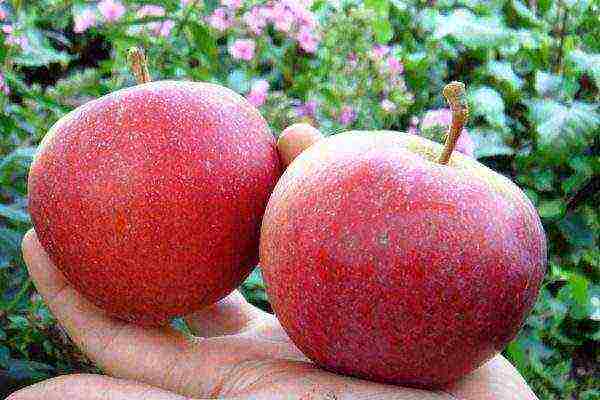
The beauty of Sverdlovsk is a very promising variety, which is being looked at not only in Russia.
Screen
A rapidly growing variety of autumn apples. It grows rapidly, reaching its maximum 3-4 m in several years. The crown is spreading, not too dense. Fruits ripen on the 10th of September. The variety is self-fertile, the first apples are harvested 4–5 years after planting.
The apples are small enough, weighing 70–95 g, slightly flattened. The skin is pale yellow with a whitish coating. Blush - pale pink blurry specks. The pulp is tender, with a pronounced aroma. The taste is rated 4.5 out of five. The fruits are low in vitamin C.
If you provide the apples with the right conditions, they can easily last until the end of winter. The screen rarely suffers from diseases, the only exception is scab.

When growing apples of the Ekranny variety, special attention should be paid to the prevention and control of scab
Amber
Autumn apple variety suitable for long storage. But for this they need to be filmed not in the 15th of September, but at the very end of August. The tree is medium-sized, the crown is wide, not thickened. The first harvest can be expected 7–8 years after planting. The variety is self-fertile.
Fruits are small, when grown on infertile soils - weighing 40-50 g, in more suitable soil they reach 70-75 g. The skin is bright, amber-yellow, there is no blush. The pulp is very dense and juicy, the taste is harmonious, sweet and sour.

Amber is a self-fertile apple tree; any variety blooming at the same time is suitable as a pollinator
In Siberia
For this region, not only high frost resistance is important, but also the height of the tree. The larger it is, the higher the likelihood that the apple tree will suffer from prolonged cold weather and piercing winds. It is also worth taking into account the short, not always warm summer.
Gornoaltaiskoe
"Semi-wild" summer variety of apples. The height of the tree is 3–3.5 m. The crown is very thick and wide (up to 6 m). The wood is loose, fragile, so skeletal branches often break. With an excess of precipitation, the fruits often crack.
The apple tree begins to bear fruit in the 4th-5th year. The apples are small, weighing up to 40 g, but the tree is literally dotted with them. The total yield is 35–40 kg from an adult apple tree. The tree has a lifespan of up to 45 years. The taste is rated at 4 points.
Fruits ripen at the very end of August. When left on a tree, they quickly overripe and acquire an unpleasant mealy taste.

The skeletal branches of the Gornoaltaiskoye apple tree often break
Altai souvenir
Autumn apples, suitable for long (3.5–4 months) storage. The tree grows up to 3 m, the crown is spherical, not thickened. The variety is immune to scab, often affected by moniliosis. Bears fruit annually.
Apples for Siberia are large, 95–125 g. The skin of apples is yellowish-white, with a crimson blush of their thin strokes and indistinct spots. The pulp is sweet and sour, crispy.
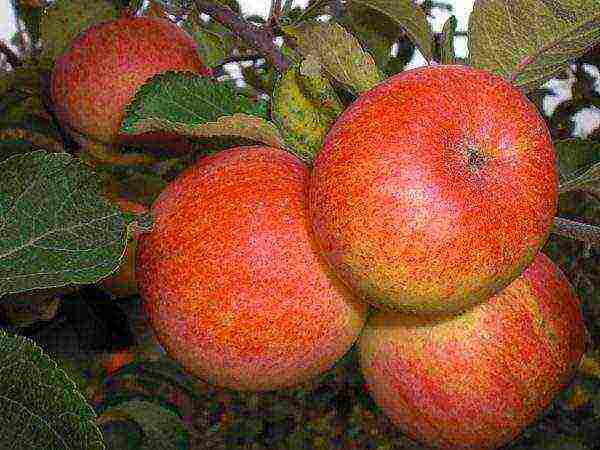
A significant drawback of the Altai Souvenir apple tree is susceptibility to moniliosis
Bayan
Self-fertile variety of winter apples, ripening in the 15th of September. Each weighs on average 100-120 g, the skin is golden, covered with longitudinal purple stripes and spots. The apples are almost spherical, with slightly pronounced ribs.
The height of the tree is up to 3.5 m, the crown is sparse. The variety is insensitive to drought, not affected by scab. Productivity - about 75 kg per apple tree, regular fruiting.
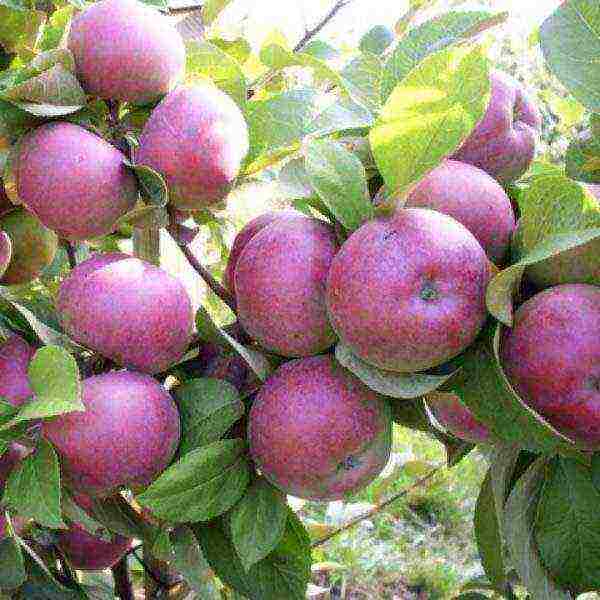
The fruits of Bayan's apple tree look very exotic due to the unusual shade of the skin.
Cherished
It is one of the most widespread varieties in Siberia. It is rarely attacked by diseases and pests. The tree grows up to 3 m or slightly less. The crown is spherical, sparse. Differs in early maturity - the first fruits are removed after 4 years.
The apples are small, weighing 55–70 g. The skin is pale salad, with a crimson blush. The pulp is dense, the characteristic smell is weak. In the sweet and sour taste, strawberry notes are guessed. Fruits ripen en masse in the 15th of September, under suitable conditions they do not spoil for 4–5 months.

Apple tree Cherished deservedly enjoys great popularity among Siberian gardeners
Darkie
A variety of summer apples grown mainly in Altai. They taper noticeably towards the base. Apples weigh no more than 45-50 g. The skin is golden, the blush is claret. The pulp is yellowish-creamy, with pinkish veins. Fruits ripen in the 15th of August, they are kept fresh for a month, no more.
The first harvest will have to wait 4–5 years, then annual fruiting. The dark-haired woman is extremely rarely affected by scab.
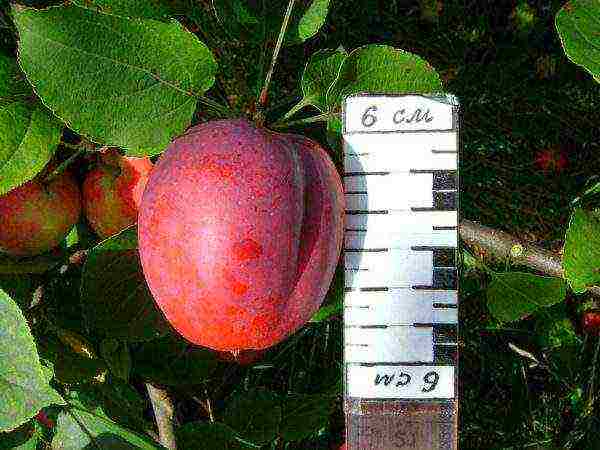
Apple-tree Smuglyanochka almost never suffers from scab
In Belarus
The climate in Belarus does not differ much from the conditions of the European part of the territory of Russia. But there they prefer varieties of their own selection:
- Darunak. It is appreciated for its immunity to scab, winter hardiness, fruit size (320-360 g), suitability for long-term (spring) storage. The skin is lettuce, almost entirely hidden by the raspberry blush.
- Imant. It is immune to scab, is frost-hardy, and bears a harvest every year. The fruit weighs about 200 g and tapers towards the bottom. The skin is deeply scarlet, with a purple tint. Stored until March-April.
- Syabryn. A variety of winter apples, which is valued for its immunity to scab, early maturity, stability and abundance of fruiting. The fruit weighs about 125–160 g. The skin is yellowish-white, the blush is indistinct crimson spots. Apples will last until February-March.
- Armor. The tree grows rather slowly. The apples are in the shape of an almost regular ball, weighing 225–250 g. The skin is slightly oily to the touch, with a bluish bloom. Color - salad with crimson blush. Flesh with a pronounced odor, crispy. Shelf life - until April.
- Elena. One of the new varieties of summer apples, characterized by cold resistance and abundant fruiting, not suffering from scab. Fruits weigh 130–160 g and ripen in September. Fruiting is stable. Lettuce peel with carmine blush. The shape is slightly flattened. Taste by professionals is estimated at 4.8 points.
- Kovalenkovskoe. Late-summer apples, trees are not very sensitive to drought. The fruits are very sweet, even unripe fruits are not sour. The greenish skin is almost invisible under the dark scarlet blush. On average, an apple weighs 125–170 g.
- Alesya. Winter apples. A distinctive feature of the variety is drought resistance. Apples weigh about 175-210 g, as if they are slightly flattened. The skin is golden, the blush is indistinct crimson spots. The pulp is rather loose.
Photo gallery: apple trees of the Belarusian selection
In Ukraine
The climate of Ukraine, especially its southern regions, is ideal for gardening. Almost any variety can be grown there, so the choice is mainly influenced by the size of the apples, their taste and visual appeal. The most popular are:
- Julia. Summer apples, you can save them for only 15–20 days. They weigh an average of 130-145 g. Salad skin is practically invisible under the pale scarlet blush. Has a genetically built immunity to scab and powdery mildew.
- Greenleaves. Autumn apples in the shape of an almost regular ball, shelf life 6-8 weeks. They weigh about 145-180 g. The skin is yellowish-green. The pulp is very firm and crispy. The taste is rated at 4.7 points. Differs in very high resistance to pathogenic fungi.
- Topaz. An excellent storage variety, stably and abundantly fruitful. The fruit will last until mid-spring. The average weight of an apple is 135–150 g.The basic skin tone is almost invisible under the reddish brown blush. Flesh with a pronounced aroma, crispy. Immune to scab, all types of rot, cancer, often suffers from powdery mildew.
- Modi. Elite apples, ripening in the last days of September, can be stored until mid-spring. The weight of a slightly flattened apple is 175–210 g. The salad skin is hidden under a deep burgundy blush. The professional assessment of taste is very high - 4.8 points.
- Williams Pride. Apples ripening in late July. The skin is greenish-silvery, with a rich scarlet blush. Fruiting is unstable. Genetically resistant to scab, powdery mildew.
- Fuji. Standing out in size (250-280 g) sweet apples, ripening in September. The high sugar content in the pulp is characteristic. The skin is yellowish, completely hidden by a blush in the form of stripes of different shades of pink, scarlet, burgundy. Often suffers from a bacterial burn, powdery mildew.
- Rubinola. Winter apples. The yield is not amazing, but stable. Fruit can stay in the refrigerator for up to six months. The fruit weighs an average of 160-190 g. The skin is yellowish, the blush, as the name suggests, is ruby.
- Florina. Winter French variety, distinguished by its early maturity. From an apple tree, 75–85 kg of fruit are obtained, each weighing 110–165 g on average. The skin is yellowish, the blush is intense scarlet. The presence of whitish spots under it is characteristic. The taste is bland, earned 4.1 points. Immune to scab, moniliosis, powdery mildew, extremely rarely affected by aphids.
- Red Jonaprince or Black Prince. Appreciated for the early maturity and size of apples (more than 250 g). Fruits ripen on the 15th of September. The skin is a deep burgundy color, from a distance it seems black. It perfectly tolerates transportation, can be stored for up to six months. The variety is self-fertile, good pollinators - Bradburn, Elstar.
Photo gallery: varieties grown in Ukraine
Triploid apple trees
They, in comparison with diploid ones, differ in a large number of chromosomes. Outwardly, this is expressed in the high height of the apple tree itself, stable annual fruiting. The apples themselves are smaller, the tree does not suffer from overload, but they are larger. At the moment, about a hundred such varieties are known, most of them were obtained by chance. None of them are used as pollinators.
- August. Ripens in the 15th of August. Not affected by scab. Fruits weighing 160-185 g, taper towards the bottom. The skin is yellowish, the blush is transparent scarlet.
- Bezhin meadow. It is valued for its abundance of fruiting, but is often affected by scab. The average weight of an apple is about 145–160 g. The skin is salad, the blush is dark crimson. The harvest is removed in early September, it is stored until the New Year.
- Grace. It stands out by the weight of the fruits (on average about 250 g), the tree for the triploid is not tall. The skin is salad green, blush in the form of vague crimson strokes. Apples ripen in the last days of September, in suitable conditions they will last until spring.
- Alexander Boyko. Winter grade. Fruits weigh on average 180–220 g. The yellowish skin is practically invisible under the orange-red blush. Differs in winter hardiness, stored until March.
- Zhilinskoe. Genetically resistant to scab. The apple tree is about 3.5 m high. The weight of the apple is 180–210 g. The skin looks like glossy, oily to the touch. Blush - wide longitudinal crimson stripes. Fruits ripen in early August.
- Patriot. Cold-resistant variety. The weight of the apple is 240–290 g. The skin is golden, the blush is vague, reddish. Fruits ripen on the 15th of September, they can be stored until February.
- Turgenevskoe. A winter variety that does not suffer from scab. Ripens towards the end of September. An apple weighs on average 180–220 g. The skin is oily to the touch, yellowish, intense blush, brick shade. Stored until March.
Photo gallery: triploid apple trees
Good and winter-hardy varieties of apples: names and descriptions
Winter-hardy apple trees are specially bred for cultivation in the Urals, Siberia, and other regions with a similar climate. At the same time, they are not only able to withstand prolonged cold weather and quickly recover if they do get damaged. They are insensitive to return spring frosts and temperature changes during thaws.
- Lingonberry. Self-infertile variety. Apples weighing 75–90 g. The skin is pale yellow, the blush is bright red, indistinct. The tree is up to 3 m high, the crown is spreading, the branches are drooping.
- Mantet. The tree is about 4 m high, the crown is sparse. The apples are elongated, with slightly pronounced ribs, weighing 110–140 g. The skin is yellow-green, covered with crimson strokes and dots. It ripens in early autumn and is stored for 15–20 days.
- July Chernenko. The tree is about 6 m high, the crown is wide. Apples weighing about 100 g, lettuce color with burgundy blush and gray wax bloom. Fruits ripen in waves, fall off when overripe.
- Early scarlet. The height of the tree is about 4 m. Apples weighing 60–75 g, asymmetrical. The greenish skin is almost completely hidden by a dark scarlet blush. Ripens in mid-August.
- Sunflower. Apple tree 3-4 m high, densely leafy crown, wide. The weight of a slightly flattened apple is 70–80 g, the skin is yellowish-white, the blush is raspberry. It ripens at the very beginning of autumn, it will not lie fresh for a long time (maximum 3 weeks).
- Auxis. The height of the apple tree is about 3.5 m, the crown is sparse. Apples weigh on average 145-175 g. The yellowish skin is practically invisible under the raspberry blush. Ripens in early autumn and is stored until the New Year.
Photo gallery: frost-resistant varieties
Undersized apple trees
Low-growing apple trees are a great option for those who need to save space in the garden. They are also much easier to care for and harvest, which is important for older gardeners. Columnar apple trees, which have recently become very popular, belong to this category.
- Moscow necklace. Winter variety of columnar apple tree. The height of the tree is about 2 m. The mass of an apple in the form of an almost regular ball varies from 120 to 250 g. The green skin is completely hidden by a maroon blush. Ripens at the end of September, is stored for 3.5-4 months. Frost resistant.
- Bratchud (Brother of the Wonderful). Winter apple variety, natural elite. The height of the tree is 1.5–2.5 m. The weight of the apple is about 150 g. The skin is yellow-green, the blush is transparent-scarlet. Ripens in early October, is stored at least until February.
- Legend. The height of the tree is about 2.5 m. The average weight of an apple is 220 g or more. The skin is deeply scarlet, covered with even darker strokes. Ripens in October and is stored for 10-12 weeks.
- Sun. It is immune to scab. The height of the apple tree is about 2 m. The weight of the apple is 160–200 g. The skin is yellowish, the blush is vague, crimson. It ripens in the 15th of September and is stored in February.
Photo gallery: dwarf trees
Popular varieties
Amateur gardeners have recently been increasingly planting varieties that had previously been successfully grown on an industrial scale. Their advantage is that all their advantages and disadvantages are well known.
- Liberty. It can be grown in the south and in central Russia. Immune to scab, but often suffers from powdery mildew. Brings 120-130 kg of fruit from an adult tree. Apple weight - 145–160 g. Salad skin, deep burgundy blush. It ripens in the 15th of September.
- Golden Resistant. Quite low cold resistance, often infected with scab and powdery mildew. Other apple trees are needed for pollination (Idared, Gloucester, Elstar). Brings 50-60 kg of fruit every year. The fruits weigh 145-170 g, the skin, as the name suggests, is golden. Ripens in late September. Annual pruning required.
- Baritone. It is rarely affected by most diseases typical for the culture, it tolerates transportation well. Apples weigh 180–220 g. The skin is maroon with a whitish bloom. Ripens in late August and is stored for about 4 weeks.
- Enterprise. It rarely becomes infected with any disease. Self-sterile. Florina, Fuji, Elstar, Granny Smith are suitable for pollination. The fruits are barrel-shaped, weighing about 175–220 g. The skin is dark scarlet. Stored until March-April.
- Ligol. A variety of winter apples. Often suffers from fire blight. Needs pollinators (Idared, Macintosh, Champion, Lobo). Annual pruning required. It stands out for its fruit size (over 250 g). Fruits with a characteristic lateral seam. The skin is glossy, yellowish, the blush is deep scarlet. Shelf life - up to six months.
- Askold. A frost-resistant variety that does not suffer from scab. Very weak resistance to powdery mildew. Brings 60–70 kg per tree. The weight of the apple is 180–210 g. The bright yellow skin is almost completely hidden by the crimson blush. It ripens in the last days, is stored at least until February.
- Champion. The variety is partially self-fertile, as pollinators Idared, Gala, Pilot are suitable. Apples are uniform, weighing 185–230 g. The yellowish skin is practically invisible under the blush of longitudinal vague reddish stripes. It ripens in early October and is stored for about six months. Does not differ in frost resistance.
Photo gallery: new varieties of apple trees
Gardeners reviews
Choosing an apple tree to grow is not an easy task. It is very easy to get confused in the wide variety of achievements of breeders. Nowadays, large tasty apples can be cultivated almost throughout Russia, with the exception of areas with arctic and subarctic climates. It is necessary to take into account many factors, first of all - the climate in the growing region.
27 years old, higher education in law, broad outlook and interest in a variety of topics.
The apple tree is perhaps the most popular fruit crop among Russian summer residents. Almost every domestic gardener grows such trees on his site. There are just a huge number of apple varieties. They may have different qualities and characteristics. And, of course, many summer residents would like to know which varieties of apples are the most delicious.
Classification of varieties
The fruits of apple trees grown by domestic summer residents can ripen at different times. All varieties of this fruit crop are divided into three main groups:
-
summer;
-
autumn;
-
winter.
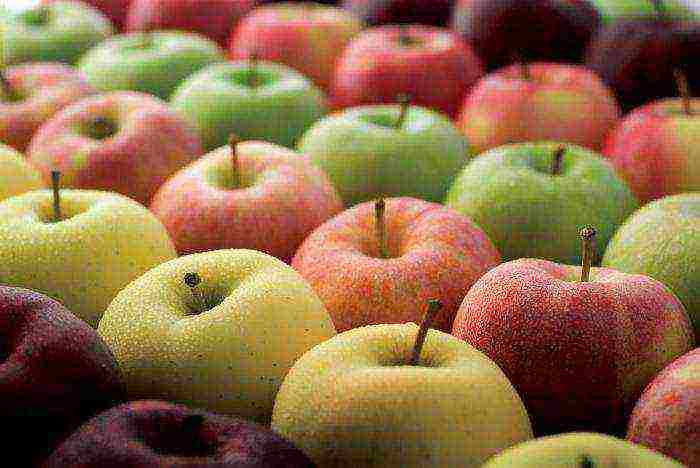
List of the most popular apple trees
The best summer varieties among Russian summer residents are considered
-
White filling.
-
Moscow pear tree.
-
Melba.
The most delicious varieties of autumn apples, according to Russian gardeners, are:
-
Zhigulevskoe.
-
Antonovka.
The best winter apple trees:
-
Simirenko.
-
Golden.
The most delicious varieties of apples, ideal for the middle lane, are White filling, Moskovskaya grushovka, Melba and Antonovka. Apple trees Simirenko, Zhigulevskoe and Golden are recommended for the southern regions of the country, Belarus and Ukraine.
White filling: description
The apple tree of this variety can reach a height of 4-5 meters. At a young age, her crown is broad-pyromidal. In the future, it takes on a rounded shape. The fruits of the White filling grow mainly on ringlets. The leaves of the apple trees of this variety are ellipsoidal, gray-green.

The fruits of the White filling are very large. Their weight can reach 110-150 grams. Ripe apples are light yellow in color. Their skin is covered with a white waxy coating. On the south side, these apples may have a slight blush. The pulp of the fruits of the White filling is coarse-grained, very juicy and sweet. This old Soviet Baltic variety is still considered by many to be the most delicious. The White filling has one rather serious drawback. With age, the fruits of such trees begin to become very shallow. In old apple trees, their weight can be only 60 g.
Fruit picking is usually done in two stages. For the first time, apples are picked on August 5-10, the second time - on 20-25. The keeping quality of the fruits of the White filling is very low. They can be stored for no more than 15-20 days. Apples of this variety are most often used fresh.But since the fruits of the White filling are very juicy, they are sometimes used to prepare various kinds of drinks - juices, liqueurs, wines.
Moscow pear
This apple tree with small bright fruits can also very often be seen in the gardens of domestic summer residents. Moscow pear is one of the oldest varieties. He was known at the end of the 18th century. Trees of this variety grow very tall. The crown in young apple trees is pyramidal, in adults it is spherical. The leaves of the Moscow pear tree are very large, and the flowers, unlike many other popular varieties, are not white, but pale pink.

The fruits of the Moscow pear are small (weighing about 50 grams), resembling a turnip in shape. They are yellow-green in color with a blurred blush. On the south side, most of the fruits are covered with bright red stripes.
The first apples of this variety ripen in early August. The impact of the Moscow pear tree is long-lasting. The fruits ripen within two weeks. Some disadvantage of the variety is the strong crumbling of apples. The advantages of the Moscow pear tree include high yield and excellent taste of the fruit. The pulp of these apples is sweet and sour, juicy, aromatic. They are used like White filling, usually fresh. Sometimes juices are also made, which, according to many summer residents, differ, among other things, in medicinal properties. You need to drink them for diseases of the bladder, liver and kidneys. Also, Moscow pear juice helps to solve problems with the nervous system and treat acute bronchitis. The disadvantage of this variety is considered only low transportability and keeping quality of fruits.
Melba
White filling and Moscow pear, according to many gardeners, are the most delicious summer varieties of apples. Melba is not far behind them in popularity. This variety was developed in Canada in 1898. It was named after one of the most famous singers of that time - Nelly Melba. This variety is grown in many regions of Russia. Not too often it can be seen only in the gardens of summer residents of the Urals, Siberia and the Far East.
Melba apple trees grow very low - about 3 meters. Their crown is columnar at a young age. You can also recognize this apple tree by its light green leaves with a yellowish tint with small teeth. Melba's flowers are very large and white.
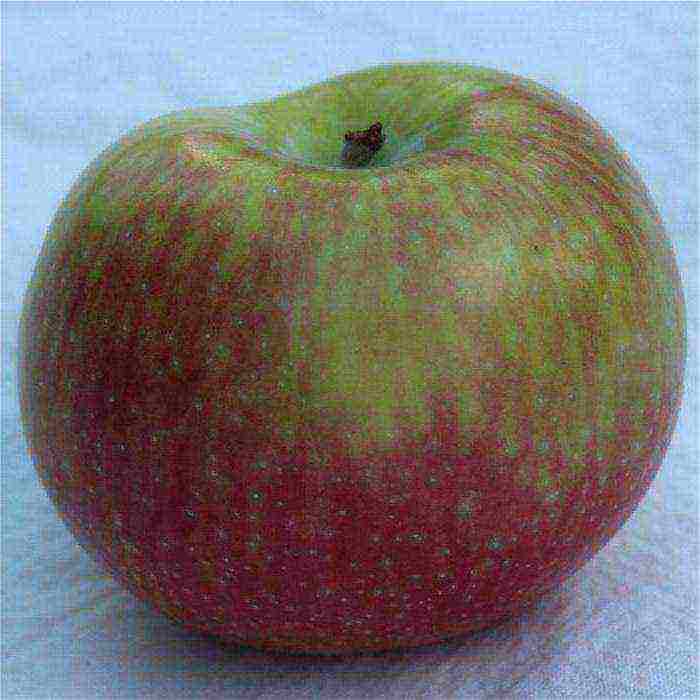
The fruits ripen around mid-August. The sizes are large, weight - 130-150 grams. The shape of apples is round, slightly flattened. The color of the Melba fruit is light green with a striped blush. The pulp is very tender, sweet, juicy and crunchy. Her color is almost snow-white. Many summer residents like not only the taste of these apples, but also their aroma. Melba fruit has a pleasant caramel smell. The advantages of the variety include yield and keeping quality, the disadvantages - instability to scab, weak winter hardiness and self-fertility.
Antonovka
The most delicious varieties of summer apples - White filling, Moskovskaya grushovka and Melba - are mostly used for fresh consumption. They cannot be stored for a long time, as already mentioned. Therefore, at the same time as summer, summer residents often plant autumn varieties of apple trees. The fruits of such trees ripen in August - September and can be stored for up to several months.
Antonovka is a late-autumn variety (in some sources it is classified as early-winter), which can be found in the gardens of domestic summer residents no less often than White filling. Antonovka was not displayed by anyone on purpose. They refer it to varieties of folk selection.
Antonovka's fruits are large, round. Many apples have ribs at the bottom. The color is green-yellow. These apples ripen around the end of September. Their flesh is sour-sweet, very aromatic. The fruits of Antonovka can be used both fresh and for making jam, marshmallow, compote, marmalade, etc. Since the pulp of these apples is dense, many people bake pies, charlottes, etc. with them.The advantages of the variety, first of all, include resistance to diseases, the disadvantages - not too good keeping quality of the fruits.

The most delicious autumn varieties of apples: Zhigulevskoe
The fruits of these apple trees ripen by the end of September. The variety is well suited for growing in Ukraine, Belarus and central regions of Russia. The fruits of Zhigulevskoe apple trees are quite large. Their weight can reach 150-160 grams. The shape of these apples is flat-round. The color is yellowish with a blurred blush and a few bright red stripes. The pulp is creamy, coarse-grained, very juicy and tender. These apples have a rich sweet and sour taste. The fruits of this variety ripen almost simultaneously.
Apple trees Simirenko
The most delicious varieties of apples are autumn, thus, according to many summer residents, these are Antonovka and Zhigulevskoe. The popular winter varieties are Simirenko and Golden Delicious. These varieties are also grown by domestic summer residents very willingly. The Simirenko apple tree has a high yield and early maturity. Its disadvantages include mainly only a weak resistance to prasha. This variety is popularly called "seven-line".
The apples of these trees are very large (up to 200 grams), but light at the same time. The fruit is round-conical in shape, and the color is light green. The flesh of Simirenko apples is greenish, dense, sweet, juicy, has a pronounced characteristic aroma. You can store the fruits for up to 7-8 months. They ripen by the end of October. The crown of this apple tree is dense, therefore, it requires periodic pruning.

The most delicious winter varieties of apples: Golden Delicious
This apple tree was first discovered in one of the states of the United States. Her crown has a conical shape. This tree grows low - only about 3 m. Its apples are quite large - up to 220 grams. The color of the fruit is golden yellow with greenish blotches. The peel is rough. The advantages of the variety include frost resistance, keeping quality and high yield. Disadvantages are considered poor resistance to scab and powdery mildew. Despite the fact that Golden Delicious tolerates frost well, it is grown mainly only in the south of the country.
The pulp of this variety is juicy and very aromatic. These apples are used most often for fresh consumption and for baking.
Instead of a conclusion
Thus, we found out which varieties of winter apples are the most delicious, and which summer and autumn varieties of this fruit crop domestic summer residents prefer to grow. In most cases, all such trees, in addition to the excellent qualities of the fruit, are also characterized by unpretentiousness and endurance. Growing them is not too difficult. But, of course, it is imperative to observe certain technologies when cultivating such fruit crops.
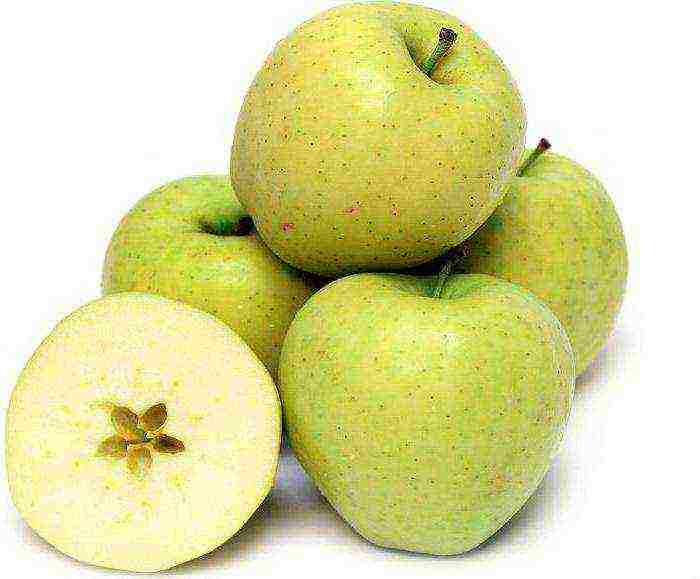
Of course, it is worth choosing the most delicious apples, taking into account the adaptability to certain climatic conditions. Varieties for the northwest, for example, are better suited to frost-resistant varieties. Just an excellent choice for growing in this case can be, for example, White filling and Melba. For cultivation in the southern regions, it is worth choosing Golden or Zhigulevskoe. With the correct selection of varieties and strict adherence to the cultivation technology from such trees, in the future it will be possible to obtain maximum yields of tasty and juicy fruits.
